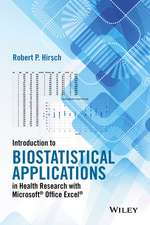Principles of Biomedical Informatics
Autor Ira J. Kaleten Limba Engleză Hardback – 13 noi 2013
It is simultaneously a unified description of the core research concept areas of biomedical data and knowledge representation, biomedical information access, biomedical decision-making, and information and technology use in biomedical contexts, and a pre-eminent teaching reference for the growing number of healthcare and computing professionals embracing computation in health-related fields.
As in the first edition, it includes many worked example programs in Common LISP, the most powerful and accessible modern language for advanced biomedical concept representation and manipulation.
The text also includes humor, history, and anecdotal material to balance the mathematically and computationally intensive development in many of the topic areas. The emphasis, as in the first edition, is on ideas and methods that are likely to be of lasting value, not just the popular topics of the day. Ira Kalet is Professor Emeritus of Radiation Oncology, and of Biomedical Informatics and Medical Education, at the University of Washington. Until retiring in 2011 he was also an Adjunct Professor in Computer Science and Engineering, and Biological Structure. From 2005 to 2010 he served as IT Security Director for the University of Washington School of Medicine and its major teaching hospitals. He has been a member of the American Medical Informatics Association since 1990, and an elected Fellow of the American College of Medical Informatics since 2011. His research interests include simulation systems for design of radiation treatment for cancer, software development methodology, and artificial intelligence applications to medicine, particularly expert systems, ontologies and modeling.
- Develops principles and methods for representing biomedical data, using information in context and in decision making, and accessing information to assist the medical community in using data to its full potential
- Provides a series of principles for expressing biomedical data and ideas in a computable form to integrate biological, clinical, and public health applications
- Includes a discussion of user interfaces, interactive graphics, and knowledge resources and reference material on programming languages to provide medical informatics programmers with the technical tools to develop systems
Preț: 476.91 lei
Preț vechi: 543.95 lei
-12% Nou
Puncte Express: 715
Preț estimativ în valută:
91.25€ • 95.53$ • 75.51£
91.25€ • 95.53$ • 75.51£
Carte tipărită la comandă
Livrare economică 29 martie-12 aprilie
Preluare comenzi: 021 569.72.76
Specificații
ISBN-13: 9780124160194
ISBN-10: 0124160190
Pagini: 708
Ilustrații: black & white illustrations, black & white tables, figures
Dimensiuni: 191 x 235 x 41 mm
Greutate: 1.56 kg
Ediția:2. Auflage.
Editura: ELSEVIER SCIENCE
ISBN-10: 0124160190
Pagini: 708
Ilustrații: black & white illustrations, black & white tables, figures
Dimensiuni: 191 x 235 x 41 mm
Greutate: 1.56 kg
Ediția:2. Auflage.
Editura: ELSEVIER SCIENCE
Public țintă
Advanced students and faculty in computing, bioinformatics and medical informatics academic programs; software engineers and programmers working in biotechnology, pharmaceutical, and medical records companies, and the medical imaging industry.Cuprins
Preface to the Second EditionForeword from the First EditionPreface from the First EditionList of FiguresList of TablesChapter 1: Biomedical DataChapter 2: Symbolic Biomedical KnowledgeChapter 3: Probabilistic Biomedical KnowledgeChapter 4: Biomedical Information AccessChapter 5: Computational Models and MethodsChapter 6: Biomedical Data, Knowledge, and Systems in ContextChapter 7: EpilogueAppendix A: Notes on Lisp, Other Languages, and ResourcesBibliographyIndex
Recenzii
"Kalet…explain(s) the principles of biomedical informatics by showing how to write computer programs that implement them. He covers biomedical data; symbolic biomedical knowledge; probabilistic biomedical knowledge; biomedical information access; computational models and methods; and biomedical data, knowledge, and systems in context. He has updated the 2009 first edition, maintaining his focus on fundamentals." --Reference & Research Book News, December 2013








